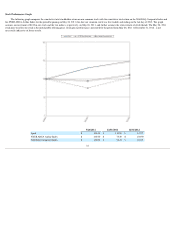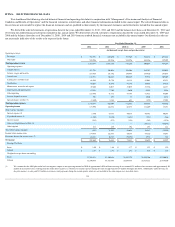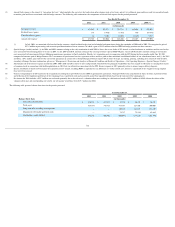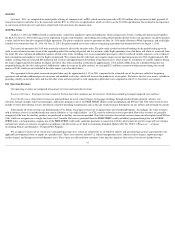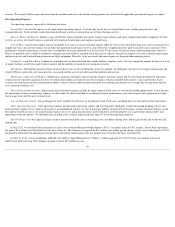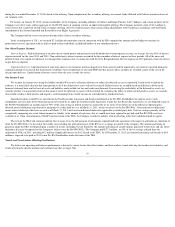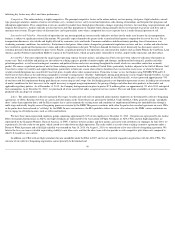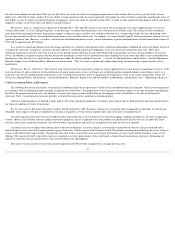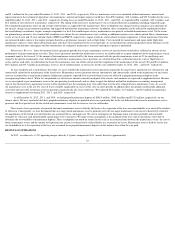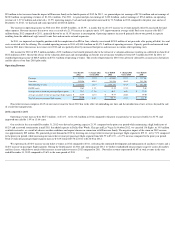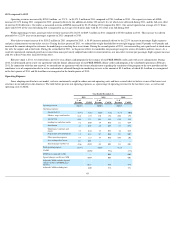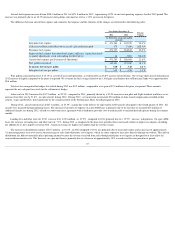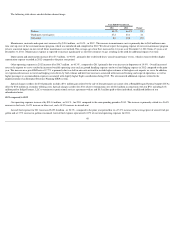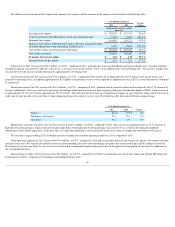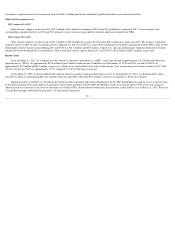Spirit Airlines 2012 Annual Report Download - page 43
Download and view the complete annual report
Please find page 43 of the 2012 Spirit Airlines annual report below. You can navigate through the pages in the report by either clicking on the pages listed below, or by using the keyword search tool below to find specific information within the annual report.
12 months. Revenues generated from the sale of FREE SPIRIT miles and credit card renewals are currently recognized on a straight-line basis over 16 months based on
expected customer usage of miles. We make assumptions on the future use of customer miles based on historical customer behavior. To the extent that customer behavior
changes as a result of, among other factors, economic conditions, perception of travel, and the number of miles to earn awards, a corresponding adjustment would be made
to the period in which we recognize revenue generated from the FREE SPIRIT miles and credit card renewals, resulting in either a smaller or larger liability. Also included
in non-ticket revenues are milestone payments in connection with the achievement of specific usage and user volumes, which we recognize when received from the FREE
SPIRIT credit card provider.
Frequent Flier Program.
We accrue for mileage credits earned through travel, including mileage credits for members with an insufficient number of mileage credits to
earn an award, under our FREE SPIRIT program based on the estimated incremental cost of providing free travel for credits that are expected to be redeemed. Incremental
costs include fuel, insurance, security, ticketing and facility charges reduced by an estimate of amounts required to be paid by the passenger when redeeming the award.
We also sell mileage credits to companies participating in the FREE SPIRIT program (or affinity card program). Under our original affinity card program, funds
received from the sale of mileage credits were accounted for as a multiple-element arrangement and allocated to a marketing component and a transportation component
(mileage credits) using the residual method. The fair value of the transportation component was deferred and recognized ratably as passenger revenue over the estimated
period the transportation was expected to be provided. The difference between the funds received and the fair value of the transportation component was recognized in non-
ticket revenue at the time of sale as non-ticket marketing revenue. The marketing component represented our compensation for, among many items, use of our trademark,
customer lists and placement of marketing materials to encourage application for credit cards. Because there were no undelivered elements other than the mileage credits, we
recorded the revenue from the marketing component when funds were received. We also received bonuses from companies participating in the FREE SPIRIT program that
are driven by the volume of the usage of our co-branded credit cards. We recognized these bonuses as non-ticket revenue when payment is received (milestone method) as
the milestones were substantive.
During the fourth quarter of 2010, the Company determined not to renew its agreement with the administrator of the FREE SPIRIT affinity credit card program at the
scheduled expiration in February 2011. We entered into a new affinity card program that became effective April 1, 2011 for the marketing of a co-branded Spirit credit card
and the delivery of award miles over a five-year period. At the inception of the arrangement, we evaluated all deliverables in the arrangement to determine whether they
represent separate units of accounting. We determined the arrangement had three separate units of accounting: (i) travel miles to be awarded, (ii) licensing of brand and
access to member lists, and (iii) advertising and marketing efforts. At inception of the arrangement, we established the relative selling price for all deliverables that qualified
for separation, as arrangement consideration should be allocated based on relative selling price. The manner in which the selling price was established was based on the
applicable hierarchy of evidence. Total arrangement consideration was then allocated to each deliverable on the basis of the deliverable's relative selling price. In
considering the hierarchy of evidence, we first determined whether vendor-specific objective evidence of selling price or third-party evidence of selling price existed. We
determined that neither vendor-specific objective evidence of selling price nor third-
party evidence existed due to the uniqueness of our program. As such, we developed our
best estimate of the selling price for all deliverables. For the selling price of travel, we considered a number of entity-specific factors including the number of miles needed
to redeem an award, average fare of comparable segments, breakage, restrictions, and other charges. For licensing of brand and access to member lists, we considered both
market-specific factors and entity-specific factors, including general profit margins realized in the marketplace/industry, brand power, market royalty rates, and size of
customer base. For the advertising and marketing element, we considered market-specific factors and entity-specific factors including, our internal costs (and fluctuations of
costs) of providing services, volume of marketing efforts, and overall advertising plan. Consideration allocated based on the relative selling price to both brand licensing and
advertising elements is recognized as revenue when earned and recorded in non-ticket revenue. Consideration allocated to award miles is deferred and recognized ratably as
passenger revenue over the estimated period the transportation is expected to be provided which is currently estimated at 16 months . We used entity-specific assumptions
coupled with the various judgments necessary to determine the selling price of a deliverable in accordance with the required selling price hierarchy. Changes in these
assumptions (e.g., cost of fare, number of miles to redeem awards, marketing plan, and approval rate of credit cards) could result in changes in the estimated selling prices.
Determining the frequency to reassess selling price for individual deliverables requires significant judgment. For additional information, please see “Notes to Financial
Statements—1. Summary of Significant Accounting Policies—Frequent Flier Program”.
Aircraft Maintenance, Materials, Repair Costs and Related Heavy Maintenance Amortization. We account for heavy maintenance under the deferral method. Under
the deferral method the cost of heavy maintenance is capitalized and amortized as a component of depreciation and amortization expense until the earlier of the next
estimated heavy maintenance event or the aircraft's return at the end of the lease term. Amortization of engine and aircraft overhaul costs was $9.1 million , $2.6 million ,
42


